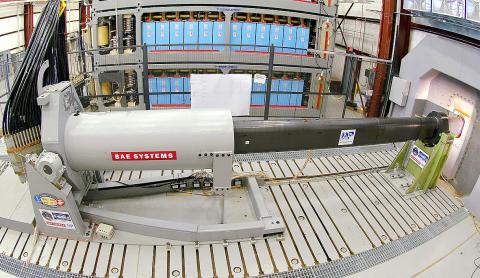New advances in the development of electromagnetic rail guns (ERG) could have a major impact on the defense of Taiwan, an expert in Asian military affairs said.
“[ERGs] could be ready by the early 2020s,” International Assessment and Strategy Center senior fellow Rick Fisher said.
US Navy officials revealed this week that they plan to test-fire a rail gun at sea for the first time in the summer of next year.

Photo: AP
The gun is to fire a series of hypervelocity projectiles fitted with GPS electronics at a barge floating in the ocean about 80km from Eglin Air Force Base in Florida.
Directed Energy and Electric Weapon Systems program manager US Navy Captain Mike Ziv told a US Navy League symposium that the first firing was a “significant event” and a “key learning point.”
The symposium was told that rail guns could fire guided, high-speed projectiles more than 160km and could be a formidable defense against cruise and ballistic missiles.
“This one technology has the potential to reverse the ‘cost-benefit ratio’ on the Taiwan Strait and to extend real deterrence potential for another decade, while allowing Taipei to sustain a largely defensive military strategy,” Fisher told the Taipei Times.
He said that Taiwan was buying US$3 million missile interceptors to shoot down US$1 million Chinese short-range ballistic missiles.
Rail guns could be able to shoot down Chinese missiles and attack aircraft with projectiles at much less cost.
“It can perform missile defense, air defense and anti-invasion missions, and also attack most of the new long-range anti-aircraft missile systems China is basing near the Taiwan Strait to threaten Taiwan’s air force,” Fisher said.
He said: “If China’s leaders see they cannot overwhelm Taiwan with missile strikes, achieve air superiority and thus assure the security of its invasion fleet, they will probably think more than twice about attacking Taiwan.”
“These are the potential benefits for Taiwan of the rail gun,” he said.
Fisher added: “It is a strategic and moral necessity for Washington to be working with Taipei to enable the early transfer of rail gun technology.”
According to the Defense Tech Web site, the rail gun being developed by the US Navy uses electricity to create a magnetic field to propel a kinetic energy projectile at about 5,600 miles per hour (9,000kph).
It can accelerate a 45-pound (20kg) projectile from zero to 5,000 miles per hour (8,046kph) in less than a second, the Web site said.
The projectiles, able to travel at 2,000 meters per second, would cost less than US$100,000 each, while the gun would be able to fire them at a rate of about one every six seconds.

Nvidia Corp yesterday unveiled its new high-speed interconnect technology, NVLink Fusion, with Taiwanese application-specific IC (ASIC) designers Alchip Technologies Ltd (世芯) and MediaTek Inc (聯發科) among the first to adopt the technology to help build semi-custom artificial intelligence (AI) infrastructure for hyperscalers. Nvidia has opened its technology to outside users, as hyperscalers and cloud service providers are building their own cost-effective AI chips, or accelerators, used in AI servers by leveraging ASIC firms’ designing capabilities to reduce their dependence on Nvidia. Previously, NVLink technology was only available for Nvidia’s own AI platform. “NVLink Fusion opens Nvidia’s AI platform and rich ecosystem for

‘WORLD’S LOSS’: Taiwan’s exclusion robs the world of the benefits it could get from one of the foremost practitioners of disease prevention and public health, Minister Chiu said Taiwan should be allowed to join the World Health Assembly (WHA) as an irreplaceable contributor to global health and disease prevention efforts, Minister of Foreign Affairs Lin Chia-lung (林佳龍) said yesterday. He made the comment at a news conference in Taipei, hours before a Taiwanese delegation was to depart for Geneva, Switzerland, seeking to meet with foreign representatives for a bilateral meeting on the sidelines of the WHA, the WHO’s annual decisionmaking meeting, which would be held from Monday next week to May 27. As of yesterday, Taiwan had yet to receive an invitation. Taiwan has much to offer to the international community’s

CAUSE AND EFFECT: China’s policies prompted the US to increase its presence in the Indo-Pacific, and Beijing should consider if this outcome is in its best interests, Lai said China has been escalating its military and political pressure on Taiwan for many years, but should reflect on this strategy and think about what is really in its best interest, President William Lai (賴清德) said. Lai made the remark in a YouTube interview with Mindi World News that was broadcast on Saturday, ahead of the first anniversary of his presidential inauguration tomorrow. The US has clearly stated that China is its biggest challenge and threat, with US President Donald Trump and US Secretary of Defense Pete Hegseth repeatedly saying that the US should increase its forces in the Indo-Pacific region

ALL TOGETHER: Only by including Taiwan can the WHA fully exemplify its commitment to ‘One World for Health,’ the representative offices of eight nations in Taiwan said The representative offices in Taiwan of eight nations yesterday issued a joint statement reiterating their support for Taiwan’s meaningful engagement with the WHO and for Taipei’s participation as an observer at the World Health Assembly (WHA). The joint statement came as Taiwan has not received an invitation to this year’s WHA, which started yesterday and runs until Tuesday next week. This year’s meeting of the decisionmaking body of the WHO in Geneva, Switzerland, would be the ninth consecutive year Taiwan has been excluded. The eight offices, which reaffirmed their support for Taiwan, are the British Office Taipei, the Australian Office Taipei, the